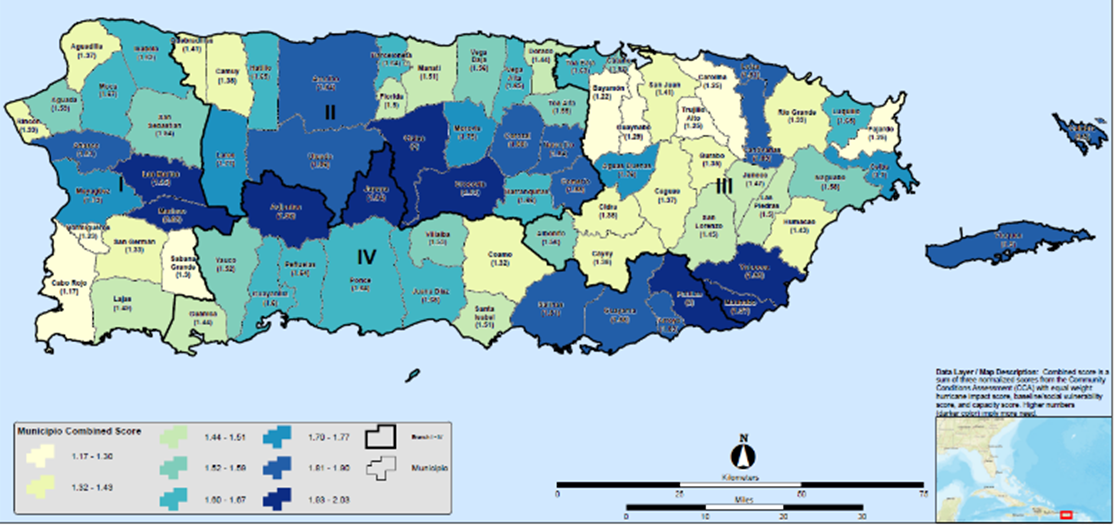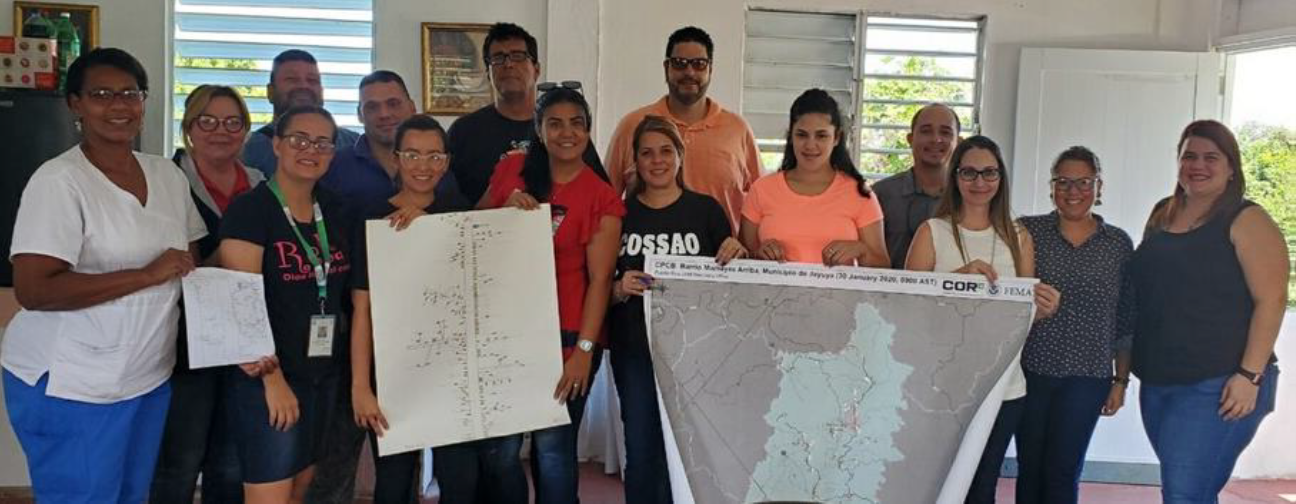Hurricanes Irma and María both impacted Puerto Rico in September 2017, causing catastrophic destruction across the island. The Community Planning and Capacity Building (CPCB) Recovery Support Function (RSF), led by FEMA, was deployed in January 2018 to provide recovery planning and technical support aimed at building communities’ capacity and resilience through the long-term recovery process. The CPCB team immediately conducted a Community Conditions Assessment (CCA), which pulls together holistic data on capacity, vulnerability and impact conditions of all communities impacted by the disaster. The CCA identified 22 priority high-risk, low-resource municipalities in need of additional technical or recovery planning support.
View Case Study

Community Planning and Capacity Building (CPCB) Recovery Support Function (RSF) Mission: CPCB’s mission is to support communities in their long-term recovery process after disasters, such as by providing planning, mapping, land use analysis, risk reduction and capacity building services.
Voluntary Agency Liaison (VAL) Mission: The VALs’ mission is to establish, foster and maintain relationships among government, voluntary, faith-based and community partners to support the delivery of inclusive and equitable services and strengthen capabilities of communities to address disaster-caused unmet needs.
Challenges
Many Puerto Rican communities, especially those in the mountainous interior of the island, had very limited resources or technical capacity to navigate complicated federal or philanthropic grants eligibility and management requirements to get community-scale recovery projects off the ground. Added challenges for isolated communities often included aging populations and limited connectivity or transportation options to urban hubs, creating a disconnect between neighborhoods and the nearest municipal government, which may be physically separated from each other by considerable distances.
The FEMA VALs identified community-based nonprofit organizations in underserved and isolated neighborhoods with unmet recovery needs. The VALs had developed trusted working relationships with these community-based organizations over several years of engagement and were interested in finding a way to better empower these small community-level organizations to build resilience in their communities.
Actions
The CPCB RSF initiated the Community Recovery Mapping Project in April 2018 to help municipalities in Puerto Rico begin visualizing their vulnerabilities through mapped information, identifying recovery needs and prioritizing long-term recovery projects. The CPCB team prioritized initial outreach to the 22 high-risk, low-resource municipalities identified by the CCA. Mapping workshops helped local governments see where potential risks and opportunities were located in their municipality, and start to think about what long-term projects might be useful to reduce those risks or pursue community development opportunities. The CPCB team was able to learn about the communities’ unique needs and priorities. The team used this understanding to build municipalities’ awareness of types of available assistance from across federal and philanthropic sources to realize long-term objectives.
The CPCB team conducted the mapping exercise with a total of 65 local municipalities out of the 78 in Puerto Rico between July 2018 and November 2019. The demand for the mapping technical assistance workshops went well beyond the initial 22 municipal governments originally identified because communities noticed the usefulness of the exercise, which helped them visualize their risks and recovery opportunities more clearly.
CPCB also provided Recovery Visualization Tools Trainings to over a dozen municipalities interested in learning how to build and maintain their own GIS-based maps to support municipal activities, using ArcGIS and/or Google Earth.
Through internal coordination, the FEMA VAL learned about the Community Recovery Mapping Project and invited the CPCB team to provide this type of tailored technical assistance to 10 community-based nonprofit organizations in high-risk, low-resource areas with enough internal capacity to receive the assistance.

Results
Communities have been able to use the maps, products and skills generated through the mapping initiative to inform their recovery efforts and successfully access additional financial resources for unmet recovery needs from philanthropic and federal sources. Mapped vulnerabilities and identified resilience projects have informed the FEMA mitigation grant program application process. The CPCB team also identified FEMA Public Assistance (PA) projects in the mapped local areas to help officials identify collaboration opportunities among departments.
Outcomes Achieved by Municipalities
A few examples of the community development projects completed through the CPCB RSF and FEMA’s Interagency Recovery Coordination (IRC) support included
- Constructing flood control and drainage projects in Comerío,
- Supporting ecological preservation and education in Florida, and
- Funding hazard mitigation and economic development in Las Marías,
- Restoring an elderly care center in Hormigueros,
- Providing trainings on green infrastructure in several municipalities,
- Installing flood mitigation projects in Yabucoa, and
- Funding several coastal erosion mitigation measures in communities on the island’s southern coast through the FEMA PA 406 Hazard Mitigation program.
Outcomes Achieved by Community-Based Organizations
The CPCB and VAL collaboration project has built capacity in 10 community-based organizations, helping them map, prioritize and fund their recovery and resilience needs. Examples of community projects supported by the mapping collaboration project include
- Enhancing local schools’ resilience, reforesting the Hacienda Sabanera in Cidra with native plants,
- Developing a QR-code connected map of tourism destinations to promote economic development in Barceloneta,
- Developing and sharing evacuation route maps with residents,
- Using the capacity built to create an incident command system in Ciales, and
- Several participating organizations successfully qualifying for funding to stand up and maintain resilience centers in their neighborhoods.
Due to the success of the mapping collaboration project, there is a backlog of requests for mapping assistance that the CPCB team is unable to commit to at this time. The high demand is an indicator that this model of coordinating mapping assistance through the VALs and CPCB RSF should be considered for replication on future disaster recovery operations.
Lessons Learned
- The CPCB RSF can provide a wide range of capacity building assistance post-disaster to fit the needs of community-based organizations and municipalities, helping to increase low-income and underserved communities’ access to critical resources that enable equitable recovery.
- Collaboration between Voluntary Agency Liaisons and the CPCB team was vital to connecting communities with unmet needs with the resources they required to recover.
- FEMA successfully built trusted relationships with communities in underserved areas over several years by engaging them and listening to their needs. This helped FEMA better understand communities’ recovery objectives and overcome barriers to holistically support them.
Additional Resources
- Hurricane María
- Hurricane Irma
- For questions about the Community Planning and Capacity Building Recovery Support Function, contact CPCB-RSF@fema.dhs.gov.

